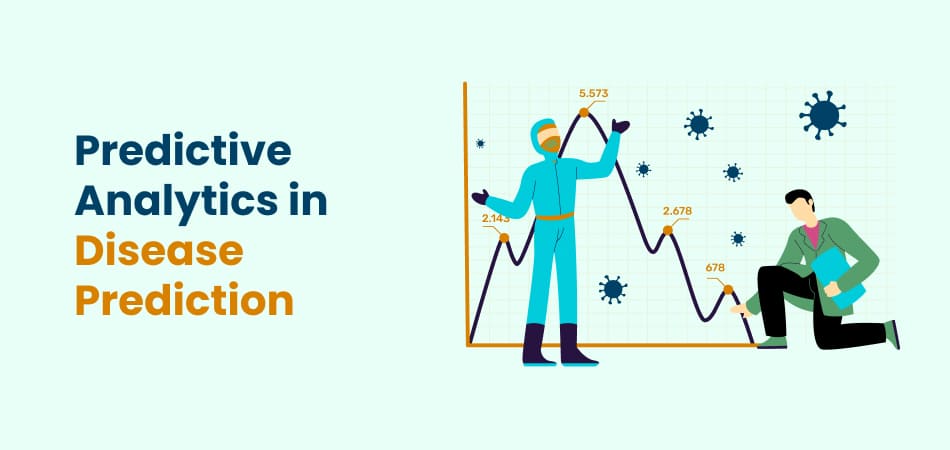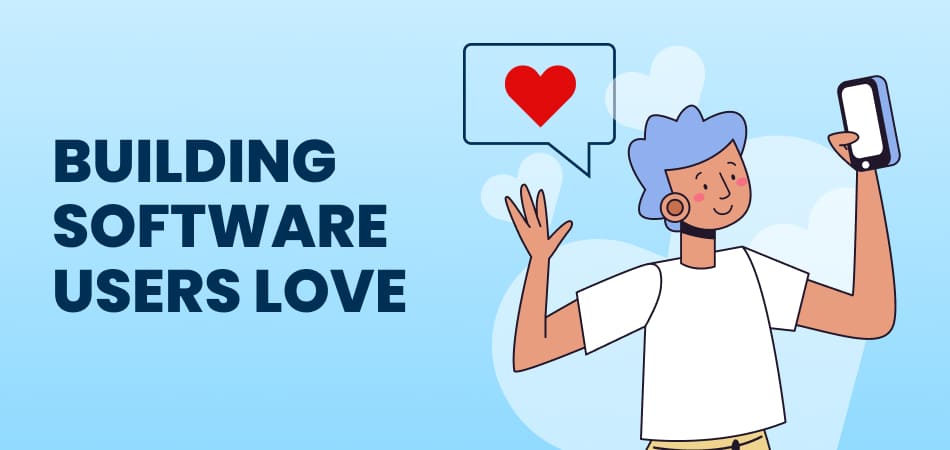What is Predictive Analytics in Healthcare?
Predictive analytics involves using statistical techniques, ML algorithms, and historical data to predict future outcomes. In healthcare, this means analyzing electronic health records (EHRs), genetic information, lifestyle habits, and environmental factors to identify potential disease risks before symptoms appear.
The process of predictive analytics in healthcare follows these key steps:
- Data Collection: Gathering patient data from EHRs, wearable devices, medical imaging, and lab results.
- Data Processing: Cleaning and structuring the data for analysis.
- Model Development: Applying AI/ML algorithms to identify patterns and risk factors.
- Prediction and Insights: Generating predictions and providing actionable insights for early intervention.
- Implementation in Healthcare Systems: Deploying predictive models into clinical workflows for real-time decision-making.
Key Technologies Powering Predictive Analytics in Healthcare
| Technology | Application in Predictive Analytics |
| Machine Learning (ML) | Identifies patterns and trends in patient data to predict disease onset. |
| Artificial Intelligence (AI) | Enhances decision-making through deep learning models. |
| Internet of Things (IoT) | Collects real-time patient data via wearable devices. |
| Big Data Analytics | Processes vast amounts of structured and unstructured healthcare data. |
| Cloud Computing | Enables remote access to predictive models and data storage. |
| Blockchain | Ensures secure and interoperable health data sharing. |
Benefits of Predictive Analytics in Disease Prediction

1. Early Disease Detection and Prevention
Predictive analytics helps in identifying diseases like cancer, diabetes, and cardiovascular conditions before symptoms manifest. Early detection allows for timely intervention, reducing mortality rates and healthcare costs.
2. Personalized Treatment Plans
AI-driven analytics tailors treatment strategies based on an individual’s genetic makeup, medical history, and lifestyle, improving patient outcomes and minimizing adverse effects.
3. Improved Patient Monitoring
Wearable technology combined with predictive analytics enables continuous monitoring of patients, detecting anomalies in vital signs and alerting healthcare providers before a crisis occurs.
4. Reduced Hospital Readmissions
Predictive models assess patient risks post-hospitalization, ensuring proper follow-ups and reducing the chances of readmissions.
5. Optimized Healthcare Resource Allocation
Hospitals can forecast disease outbreaks and patient surges, allowing better staffing, equipment allocation, and efficient healthcare service delivery.
6. Epidemiological Forecasting
By analyzing data from past pandemics, climate patterns, and population density, predictive analytics helps in forecasting and mitigating disease outbreaks such as influenza or COVID-19.
| Benefit | Impact on Healthcare |
| Early Detection | Reduces disease progression and treatment costs. |
| Personalized Treatment | Enhances patient outcomes through targeted therapies. |
| Patient Monitoring | Provides real-time insights for better health management. |
| Readmission Reduction | Lowers hospitalization rates and healthcare expenses. |
| Resource Allocation | Ensures hospitals are well-prepared for patient surges. |
| Epidemiological Forecasting | Helps governments and organizations prepare for disease outbreaks. |
Real-World Applications of Predictive Analytics in Disease Prediction
1. Cancer Prediction and Early Diagnosis
AI-powered models analyze genetic data and imaging scans to detect cancerous growths at an early stage. For instance, IBM Watson for Oncology assists oncologists in diagnosing and recommending treatments based on patient data.
2. Cardiovascular Disease Risk Prediction
Predictive models analyze cholesterol levels, blood pressure, and ECG data to assess heart disease risks. The Framingham Heart Study is a famous example that has helped predict heart disease likelihood using patient data.
3. Diabetes Prevention and Management
By monitoring glucose levels, diet, and physical activity, AI-driven solutions provide early warnings about diabetes risk, allowing individuals to take preventive measures.
4. Alzheimer’s and Dementia Prediction
AI models analyze MRI scans and cognitive test results to predict the likelihood of developing neurodegenerative diseases like Alzheimer’s, leading to early interventions.
5. Infectious Disease Outbreak Forecasting
Public health agencies use predictive analytics to track disease spread and predict outbreaks. Google Flu Trends, for instance, leveraged search engine data to anticipate flu outbreaks in different regions.
6. Sepsis Prediction in ICUs
Hospitals deploy AI algorithms to analyze patient vitals in real-time and detect signs of sepsis, a life-threatening infection, reducing mortality rates significantly.
7. Mental Health Predictions
Machine learning models analyze social media activity, speech patterns, and wearable device data to detect mental health conditions like depression and anxiety early.
| Disease | Predictive Analytics Application |
| Cancer | AI-powered image recognition for early detection. |
| Cardiovascular Disease | ECG and cholesterol-based risk assessments. |
| Diabetes | Glucose monitoring and early warning alerts. |
| Alzheimer’s | MRI and cognitive test analysis for early diagnosis. |
| Infectious Diseases | Surveillance models for outbreak predictions. |
| Sepsis | Real-time ICU patient monitoring. |
| Mental Health | AI-driven social media and speech analysis. |
Challenges in Implementing Predictive Analytics in Healthcare

1. Data Privacy and Security Concerns
With sensitive patient data being collected and analyzed, ensuring data protection and compliance with regulations like HIPAA and GDPR is crucial.
2. Data Quality and Integration Issues
Healthcare data is often fragmented across different systems. Integrating diverse datasets while ensuring accuracy and consistency remains a challenge.
3. Bias in AI Algorithms
Predictive models can be biased if trained on non-representative datasets, leading to inaccurate predictions, especially for minority groups.
4. Regulatory and Ethical Challenges
Using AI in healthcare raises ethical concerns about accountability, transparency, and the risk of misdiagnosis leading to improper treatment decisions.
5. Resistance to AI Adoption
Healthcare professionals may be skeptical about trusting AI-driven predictions, necessitating proper training and explainable AI models to gain confidence in these systems.
Future Trends in Predictive Analytics for Disease Prediction
| Trend | Description |
| Integration of AI and Genomics | Advancements in genomic sequencing combined with predictive analytics will enable highly accurate disease risk assessments, allowing for personalized medicine at an unprecedented scale. |
| Expansion of IoT and Wearable Technology | Smartwatches, fitness trackers, and biosensors will continuously collect patient health data, providing real-time predictive insights to prevent diseases before they occur. |
| Blockchain for Secure Data Sharing | Blockchain technology will enhance security and interoperability in healthcare data exchange, ensuring tamper-proof records while maintaining patient privacy. |
| Cloud-Based AI Solutions | Cloud computing will make predictive analytics more accessible, allowing hospitals and clinics of all sizes to deploy AI-driven healthcare solutions. |
| AI-Powered Virtual Health Assistants | AI chatbots and virtual assistants will provide predictive insights based on a patient’s symptoms, medical history, and real-time health data, assisting in preliminary diagnoses and reducing hospital visits. |
Conclusion
Predictive analytics is reshaping the future of healthcare by enabling early disease detection, personalized treatment, and efficient healthcare resource management. From predicting cancer and heart disease risks to forecasting epidemics, AI-driven analytics is saving lives and revolutionizing patient care.
Despite challenges like data security, bias, and integration complexities, continuous advancements in AI, IoT, and cloud computing are paving the way for more accurate and accessible predictive healthcare solutions.
As technology continues to evolve, predictive analytics will play a vital role in shifting healthcare from reactive to proactive care, ultimately improving global health outcomes and saving countless lives.


